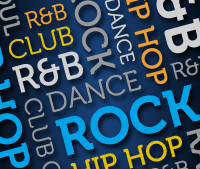It all sounds the same. Homogenized. Unadventurous. That’s what many people think about today’s mainstream music.
However, when you look more closely at the songs that top the charts, it becomes apparent that nothing could be further from the truth. Many of the hits that land in the Top 10 possess a clever fusion of sub-genres and influences that:
- Make the song more engaging and memorable.
- Help the song stand out from its mainstream contemporaries via interesting and at times unconventional pairings.
- Increase the fan base and sales potential of the artist and song by traversing multiple genres.
If you turned on the radio during Q4-2015, you heard 20 different sub-genres and influencers in the 21 songs that charted in the Top 10 of the Billboard Hot 100. Among them were some of the usual suspects – R&B/Soul, Electropop, and Hip Hop/Rap – but also less common influences like Garage, Rockabilly, and Jazz.
In this article, excerpted from our Q4-2015 Genre Report, we examine how diverse sub-genres and influencers come together in shaping the sound of three of the quarters hits – Hotline Bling, Hello, and Same Old Love.
[Header1 header=”Hotline Bling”]
Hotline Bling is an R&B/Soul song that features Trap, Hip Hop/Rap, Retro (early 1970s) and Modern (2010s) sub-genres and influences. The song also possesses a few distinct vibes, which are put into effect via the characteristics of the backing music (mellow groove) and the vocals (hurt/tender, subdued excitement, and frustration/hurt) in various sections throughout the song.
[Header2 header=”Composition”]
The entire song features an R&B/Soul influence due to elements of both the accompaniment and Drake’s vocal style. Trap plays a role in all sections save for the first half of the third chorus, bridge, and outro. It’s put into effect via the characteristics of the non-Retro instrumentation including the sub bass, kick, bright clap, rapid-fire hi-hat, and the characteristics of the beat. Hip Hop/Rap plays its most prominent role in the bridge due to Drake’s shift to a Rap styled delivery in the second half of the section. The entire song save for the bridge features an early 1970s Retro influence due to the prominent sample of Timmy Thomas’s 1972 hit, Why Can’t We Live Together (organ and percussion).
Key: All Charts
I/i: An influence that is put into effect via instrumentation/accompaniment characteristics
V/v: An influence that is put into effect via vocal characteristics
L/l: An influence that is put into effect via lyrical characteristics
Uppercase: A primary influence in the section
lowercase: A secondary influence in the section
I=Intro, A=Verse, PC=Pre-Chorus, B=Chorus, C=Bridge, VB=Vocal Break, O=Outro, X/Y=First/Second half of the section
[Header1 header=”Hello”]
Hello is a Pop Ballad/Power Ballad with a strong R&B/Soul influence. While it’s certainly not as “adventurous” as some of the other songs that chart in the Top 10, its limited influences serve the song perfectly. Together they function to both bring Adele’s heartfelt lyrics to life, and provide the listener with a very engaging, impactful listening experience. Hello also possesses a few distinct vibes, which are put into effect via characteristics of both the accompaniment and Adele’s vocal in different sections throughout the song. They include melancholy/subdued, brooding/slow-burning groove, and longing/hurt/soaring/powerful.
[Header2 header=”Composition”]
Hello’s R&B/Soul influence is put into effect via the characteristics of Adele’s vocals throughout the song. The intro, verse, pre-chorus, and outro sections all feature a Ballad vibe due to the characteristics of both the accompaniment and Adele’s subdued vocal delivery. The Power in this Power Ballad is put into effect both via the changeup to heavier, fuller instrumentation in the accompaniment and Adele’s more powerful delivery in the chorus and vocal break sections.
[Header1 header=”Same Old Love”]
Same Old Love is a Pop song that features Jazzy Chill/Lounge, Electropop, Retro (1960s), Snap, and Trap sub-genres and influencers. The song also possesses a few distinct vibes, including sullen, fed up/angst/rage, tension, sensual/seductive, and mellow/chill.
[Header2 header=”Composition”]
The entire song possesses a straight-up Pop influence, which is put into effect via the characteristics of both the accompaniment and the vocals. Snap/Trap and Electropop play a primary role in the second pre-chorus, chorus, and bridge sections due to the characteristics of the accompaniment. The entire song save for the second pre-chorus and bridge possesses a Jazzy Chill/Lounge influence, which is primarily put into effect via the accompaniment and also Gomez’s vocal characteristics in the first, second verse and first pre-chorus. All of the sections in the song save for the second pre-chorus and bridge feature a distinct Retro 1960s vibe which is put into effect via the characteristics of the accompaniment – specifically the electric piano and guitar. It’s most pronounced in the prominent Jazzy Chill/Lounge intro, verse, and pre-chorus 1 sections.
Hit Songs Deconstructed PRO subscribers can access the full Q4-2015 Genre Report by clicking here. Not a PRO subscriber? Click here to sign up!



